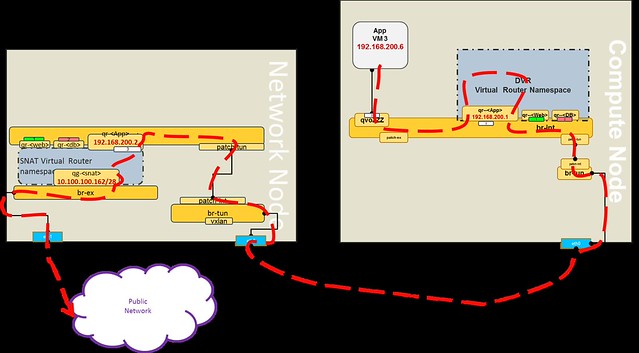In this post, the last of a 3-post series about Openstack Juno DVR, I go into the North-South SNAT scenario in details.
Up until Juno, all L3 traffic was sent through the network node. In Juno, DVR was introduced to distribute the load from the network node onto the compute nodes.
The L3 networking in Neutron is divided into 3 main services:
- East-West communication: IP traffic between VMs in the data center
- Floating IP (aka DNAT): The ability to provide a public IP to a VM, making it directly accessible from public networks (i.e. internet)
- Shared IP (aka SNAT): The ability to provide public network access to VMs in the data center using a shared (public) IP address
In my previous posts, I covered how DVR distributes the the East-West L3 traffic and the DNAT North-South.
In this post I finish covering the North-South traffic with the Shared IP (SNAT).
SNAT Shared Gateway North-South
The SNAT North-South shared public gateway functionality was not distributed by DVR. It remains centralized on the Network Node, as you can see in the diagram below.
In order to configure the SNAT namespaces on the Network node, the SNAT-DVR L3 agent is deployed.
An additional private address is assigned in the SNAT namespace for each of the DVR connected subnets, thus providing the centralized SNAT functionality.
Lets follow a communication flow from VM3 in the App network to the public network.
In my next post I will summarize the DVR solution in Openstack Juno.
In order to configure the SNAT namespaces on the Network node, the SNAT-DVR L3 agent is deployed.
An additional private address is assigned in the SNAT namespace for each of the DVR connected subnets, thus providing the centralized SNAT functionality.
Lets follow a communication flow from VM3 in the App network to the public network.
- The packet is forwarded to the DVR namespace via the local DVR default gateway port
- If the packet destination is not private, then it is routed to the appropriate default public gateway port (based on the source subnet) on the SNAT namespace
- An OVS flow converts the local VLAN into the App network segmentation ID
- The packet is forwarded into the SNAT namespace and NAT-ed using the SNAT public address
Let's look at a concrete example:
[Public Network range]=10.100.100.160/28
[App Network]=192.168.200.0/24
[Shared Public IP (SNAT)]=10.100.100.162
[VM3 private IP]=192.168.200.6
In my next post I will summarize the DVR solution in Openstack Juno.
Questions and comments are welcome.
The configuration files I used to set-up the Openstack Neutron into DVR mode can be found here.
The configuration files I used to set-up the Openstack Neutron into DVR mode can be found here.


Very nice post! Thanks.
ReplyDeleteI am trying to configure shared SNAT and DVR for floating ips. Can you share config files for neutron?
ReplyDeleteDo you think that it is production ready? I do not think so. Thanks
Thanks for the suggestion, I’ll post the config files shortly.
DeleteYour question is very good – I will address it in my next post. I believe that the DVR approach is too complex and has management and performance issues, however I did not [yet] evaluate it in a real production environment.
Great post! Thanks for sharing. One question: why hasn't the shared IP service been distributed as well? I thought the reason was to avoid allocating one IP from the public network range to every compute node, but that's already been done for the floating IP ARP-proxy...
ReplyDeleteYou are correct, the reason is to avoid allocating "Expensive" IP address from the public network. The IP allocation for the FIP is a design issue and it is being handled in liberty cycle.(link below)
ReplyDeletehttps://blueprints.launchpad.net/neutron/+spec/eliminate-dvr-fip-ns
With this constraint it is possible to develop SNAT distribution using port range on the SNAT public address per compute node or reactive SDN module on the local external bridge